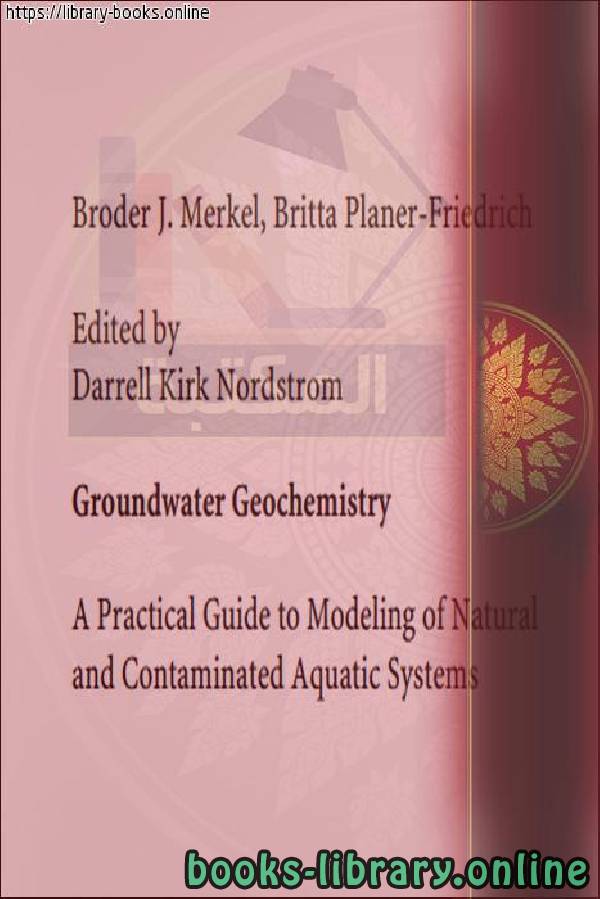📘 قراءة كتاب Groundwater Geochemistry أونلاين


Biologically
Biology is a natural science that is concerned with the study of life, its various forms and its function, how these organisms interact with each other and with the surrounding environment. The word biology in Greek is made up of two words: bio (βίος) meaning life. And loggia (-λογία) means science or study. Biology: the similarity of vegetation and animal cover on the edges of the African and American states, and the existence of the same fossil.
Branches of biology
Biology is an ancient science thousands of years old and modern biology began in the nineteenth century. This science has multiple branches. Among them are:
Anatomy
Botany
Biochemia
Biogeography
Biofisia
Cytology or cell science
Ecology or environmental science
نبذه عن الكتاب:
Biology
Human biology
Who is the founder of biology?
The importance of biology
Areas of work in the field of biology
Theories of biology
Research on biology for the first grade of secondary school
Human biology
نبذه عن الكتاب:
Theoretical Background.........................................................................1
1.1 Equilibrium reactions....................................................................................1
1.1.1 Introduction...........................................................................................1
1.1.2 Thermodynamic fundamentals..............................................................4
1.1.2.1 Mass action law.............................................................................4
1.1.2.2 Gibbs free energy ..........................................................................6
1.1.2.3 Gibbs phase rule............................................................................7
1.1.2.4 Activity..........................................................................................8
1.1.2.5 Ionic strength.................................................................................8
1.1.2.6 Calculation of activity coefficient ...............................................10
1.1.2.6.1. Theory of ion dissociation.................................................10
1.1.2.6.2. Theory of ion interaction...................................................12
1.1.2.7 Theories of ion dissociation and ion interaction..........................14
1.1.3 Interactions at the liquid-gaseous phase boundary..............................17
1.1.3.1 Henry-Law ..................................................................................17
1.1.4 Interactions at the liquid-solid phase boundary...................................18
1.1.4.1 Dissolution and precipitation.......................................................18
1.1.4.1.1. Solubility product..............................................................18
1.1.4.1.2. Saturation index.................................................................20
1.1.4.1.3. Limiting mineral phases ....................................................22
1.1.4.2 Sorption.......................................................................................24
1.1.4.2.1. Hydrophobic /hydrophilic substances ...............................24
1.1.4.2.2. Ion exchange......................................................................24
1.1.4.2.3. Mathematical description of the sorption ..........................30
1.1.5 Interactions in the liquid phase ...........................................................34
1.1.5.1 Complexation ..............................................................................34
1.1.5.2 Redox processes..........................................................................36
1.1.5.2.1. Measurement of the redox potential ..................................36
1.1.5.2.2. Calculation of the redox potential .....................................37
1.1.5.2.3. Presentation in predominance diagrams ............................41
1.1.5.2.4. Redox buffer......................................................................45
1.1.5.2.5. Significance of redox reactions .........................................46
1.2 Kinetics.......................................................................................................49
1.2.1 Kinetics of various chemical processes...............................................49
1.2.1.1 Half-life.......................................................................................49
1.2.1.2 Kinetics of mineral dissolution....................................................50
1.2.2 Calculation of the reaction rate ...........................................................51
1.2.2.1 Subsequent reactions...................................................................52
VIII Table of contents
1.2.2.2 Parallel reactions .........................................................................53
1.2.3 Controlling factors on the reaction rate...............................................53
1.2.4 Empiric approaches for kinetically controlled reactions.....................55
1.3 Reactive mass transport ..............................................................................57
1.3.1 Introduction.........................................................................................57
1.3.2 Flow models........................................................................................57
1.3.3 Transport models ................................................................................57
1.3.3.1 Definition ....................................................................................57
1.3.3.2 Idealized transport conditions .....................................................58
1.3.3.3 Real transport conditions.............................................................60
1.3.3.3.1. Exchange within double-porosity aquifers ........................61
1.3.3.4 Numerical methods of transport modeling ..................................63
1.3.3.4.1. Finite-difference / finite-element method..........................63
1.3.3.4.2. Coupled methods...............................................................65
2 Hydrogeochemical Modeling Programs .............................................67
2.1 General........................................................................................................67
2.1.1 Geochemical algorithms .....................................................................67
2.1.2 Programs based on minimizing free energy........................................69
2.1.3 Programs based on equilibrium constants...........................................70
2.1.3.1 PHREEQC...................................................................................70
2.1.3.2 EQ 3/6 .........................................................................................72
2.1.3.3 Comparison PHREEQC – EQ 3/6...............................................73
2.1.4 Thermodynamic data sets....................................................................76
2.1.4.1 General ........................................................................................76
2.1.4.2 Structure of thermodynamic data sets .........................................78
2.1.5 Problems and sources of error in geochemical modeling....................80
2.2 Use of PHREEQC.......................................................................................84
2.2.1 Structure of PHREEQC under the Windows surface..........................84
2.2.1.1 Input ............................................................................................85
2.2.1.2 Thermodynamic data...................................................................93
2.2.1.3 Output..........................................................................................94
2.2.1.4 Grid .............................................................................................95
2.2.1.5 Chart............................................................................................95
2.2.2 Introductory Examples for PHREEQC Modeling...............................95
2.2.2.1 Equilibrium reactions ..................................................................95
2.2.2.1.1. Example 1: Standard output – seawater analysis...............96
2.2.2.1.2. Example 2 equilibrium – solution of gypsum....................98
2.2.2.2 Introductory examples for kinetics..............................................99
2.2.2.2.1. Defining reaction rates ....................................................100
2.2.2.2.2. BASIC within PHREEQC...............................................103
2.2.2.3 Introductory example for reactive mass transport .....................106
Biology
Human biology
Who is the founder of biology?
The importance of biology
Areas of work in the field of biology
Theories of biology
Research on biology for the first grade of secondary school
Human biology
سنة النشر : 2005م / 1426هـ .
حجم الكتاب عند التحميل : 3.620 .
نوع الكتاب : pdf.
عداد القراءة:
اذا اعجبك الكتاب فضلاً اضغط على أعجبني و يمكنك تحميله من هنا:

شكرًا لمساهمتكم
شكراً لمساهمتكم معنا في الإرتقاء بمستوى المكتبة ، يمكنكم االتبليغ عن اخطاء او سوء اختيار للكتب وتصنيفها ومحتواها ، أو كتاب يُمنع نشره ، او محمي بحقوق طبع ونشر ، فضلاً قم بالتبليغ عن الكتاب المُخالف:
 قبل تحميل الكتاب ..
قبل تحميل الكتاب ..
يجب ان يتوفر لديكم برنامج تشغيل وقراءة ملفات pdf
يمكن تحميلة من هنا 'http://get.adobe.com/reader/'


 منصّة المكتبة
منصّة المكتبة 